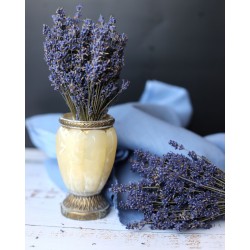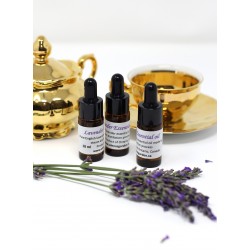
The Different Species of Lavender and What They’re Used For
Lavender is more than just a beautiful purple flower—it’s a fragrant herb with a long history of use in medicine, aromatherapy, cooking, and cosmetics. But did you know that there are over 45 species and more than 450 varieties of lavender? Each has its own unique scent, appearance, and purpose.
In this post, we’ll explore the most common species of lavender, how to identify them, and what each is best used for.
1. Lavandula angustifolia (English Lavender)
Despite its name, English lavender actually originates from the Mediterranean. It’s one of the most popular and versatile lavender species.
Characteristics:
-
Compact shrubs with narrow gray-green leaves
-
Sweet, floral fragrance
-
Blooms in early to mid-summer
Uses:
-
Aromatherapy: Calming and relaxing; often used in essential oils to ease anxiety and promote sleep.
-
Culinary: Ideal for cooking and baking due to its mild, sweet flavor. Common in lavender sugar, honey, teas, and desserts.
-
Crafts: Perfect for sachets, dried arrangements, and potpourri.
Popular Varieties:
-
‘Hidcote’ (deep purple blooms, compact growth)
-
‘Munstead’ (early blooming, great for edging gardens)
2. Lavandula x intermedia (Lavandin)
This is a hybrid between English lavender (L. angustifolia) and Portuguese lavender (L. latifolia). It’s often grown commercially for essential oil production.
Characteristics:
-
Taller and bushier than English lavender
-
Long flower spikes with strong scent
-
Blooms in mid to late summer
Uses:
-
Essential Oils: Produces more oil than English lavender, though the scent is sharper and more camphorous. Common in cleaning products and soaps.
-
Decorative: Excellent for fresh or dried flower arrangements.
-
Aromatherapy: Great for energizing blends, thoughless gentle on sensitive skin.
Popular Varieties:
-
‘Grosso’ (used in perfumes and oils)
-
‘Provence’ (known for beautiful long stems and fragrance)
3. Lavandula stoechas (Spanish or French Lavender)
Known for its striking appearance, L. stoechas features “rabbit ear” petals atop its flower spikes—making it a standout in any garden.
Characteristics:
-
Distinctive bracts (the “ears”) in bright purple or pink
-
Strong, slightly medicinal scent
-
Thrives in hot, dry climates
Uses:
-
Ornamental: Highly decorative and often used in Mediterranean-style gardens.
-
Aromatherapy: The scent is invigorating but less sweet than English lavender.
-
Pollinator-Friendly: Attracts bees and butterflies.
Popular Varieties:
-
‘Anouk’ (compact, deep purple flowers)
-
‘Otto Quast’ (vigorous grower, long blooming season)
4. Lavandula dentata (French or Fringed Lavender)
Often confused with L. stoechas, this variety has toothed leaves (hence “dentata”) and a softer, more rounded flower head.
Characteristics:
-
Gray-green leaves with serrated edges
-
Mild, pleasant fragrance
-
Blooms almost year-round in warm climates
Uses:
-
Decorative: Great for containers, patios, and garden borders.
-
Fragrance: Common in natural perfumes and home fragrance blends.
-
Culinary: Occasionally used in savory dishes, though flavor is lighter than L. angustifolia.
Popular Varieties:
-
‘Royal Crown’ (vibrant blooms and compact shape)
-
‘Candicans’ (silvery foliage, fragrant flowers)
5. Lavandula multifida (Egyptian Lavender or Fernleaf Lavender)
This species is less common but loved for its deeply divided leaves and unusual texture.
Characteristics:
-
Fern-like foliage
-
Blue-purple flowers
-
Tolerates heat and poor soil
Uses:
-
Ornamental: Excellent in xeriscaping and drought-tolerant gardens.
-
Aromatherapy: Strong, camphorous scent with cleansing properties.
-
Pollinator Plant: Attracts bees in dry, hot environments.
Choosing the Right Lavender for You
When selecting lavender, think about your climate and intended use:
| Purpose | Best Species | Notes |
|---|---|---|
| Culinary | L. angustifolia | Sweet and mild flavor |
| Essential oils (strong scent) | L. x intermedia | High oil yield, sharper aroma |
| Ornamental garden | L. stoechas or L. dentata | Showy flowers, long blooming |
| Drought-tolerant landscaping | L. multifida | Tough and heat-tolerant |
| Relaxation & sleep | L. angustifolia | Gentle, soothing aroma |
Final Thoughts
Lavender’s versatility is what makes it truly magical. Whether you’re looking to calm your mind, scent your home, flavor your meals, or simply brighten your garden, there’s a lavender species for every purpose.
By understanding the unique qualities of each type, you can make the most of this beloved herb—and enjoy its beauty and fragrance year-round.





-250x250w.JPG)


Leave a Comment